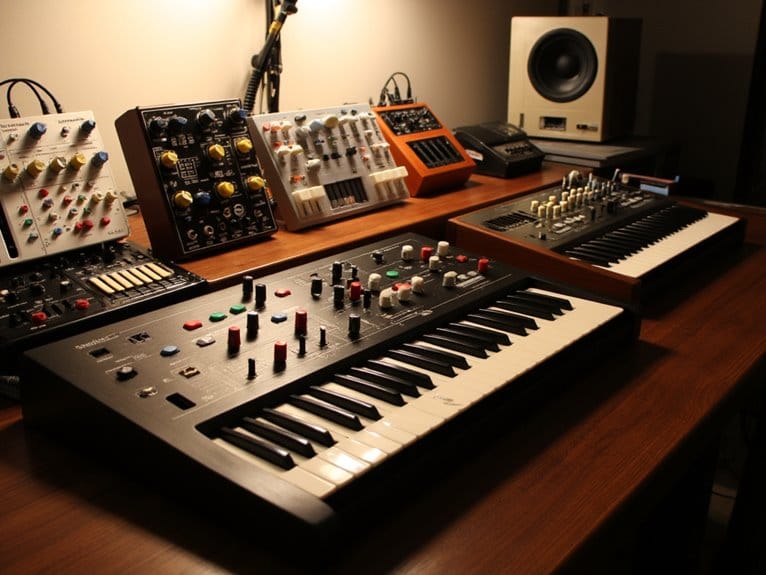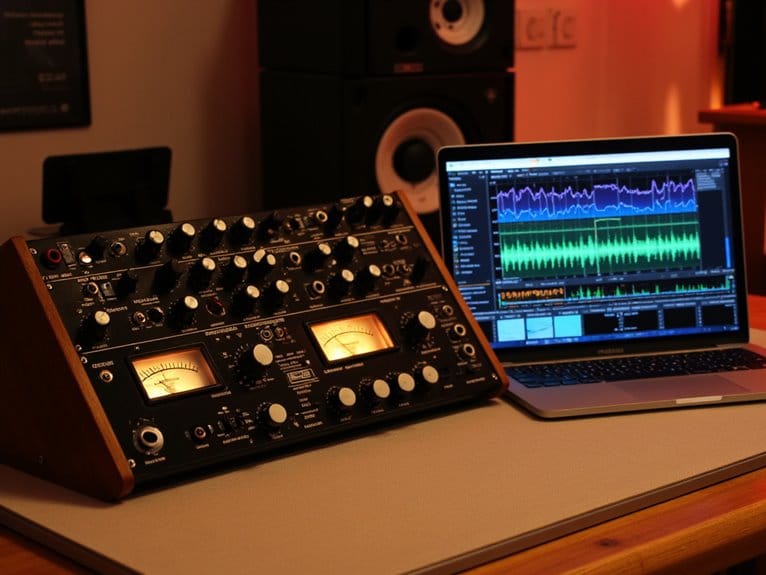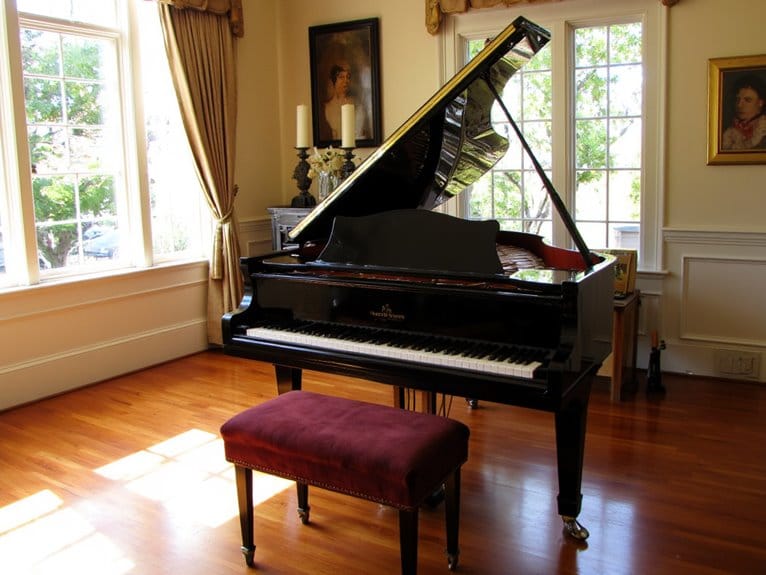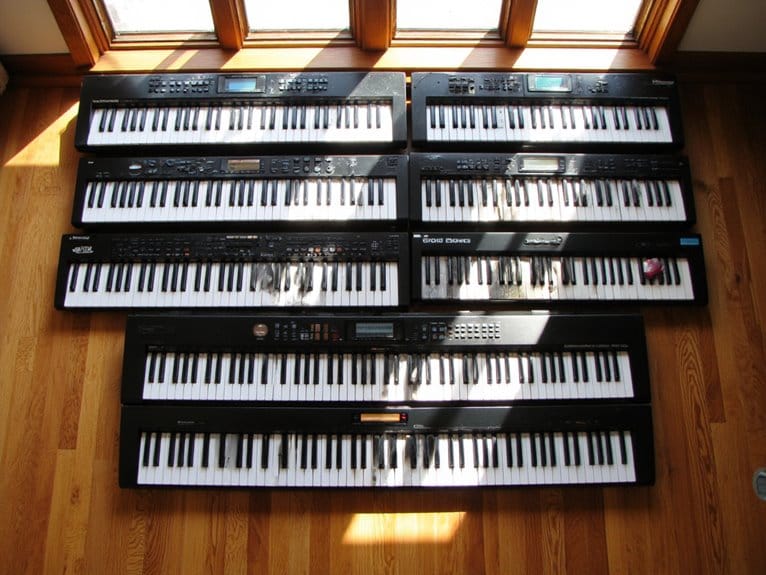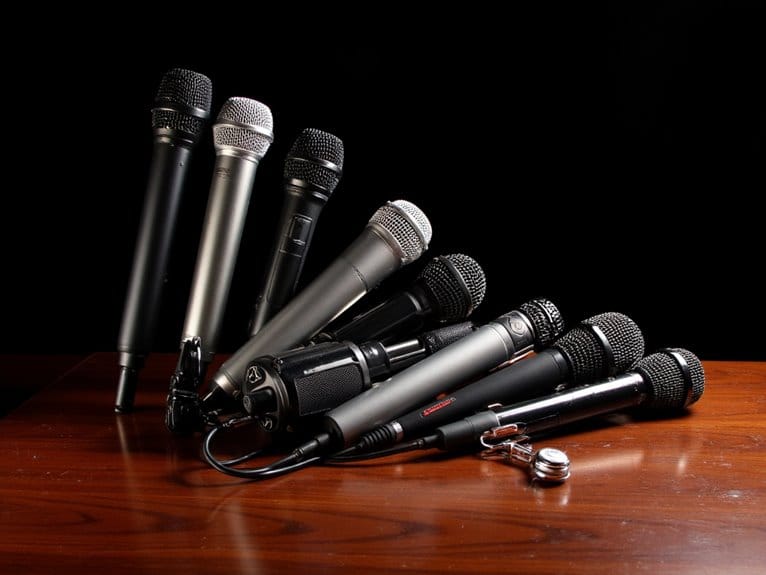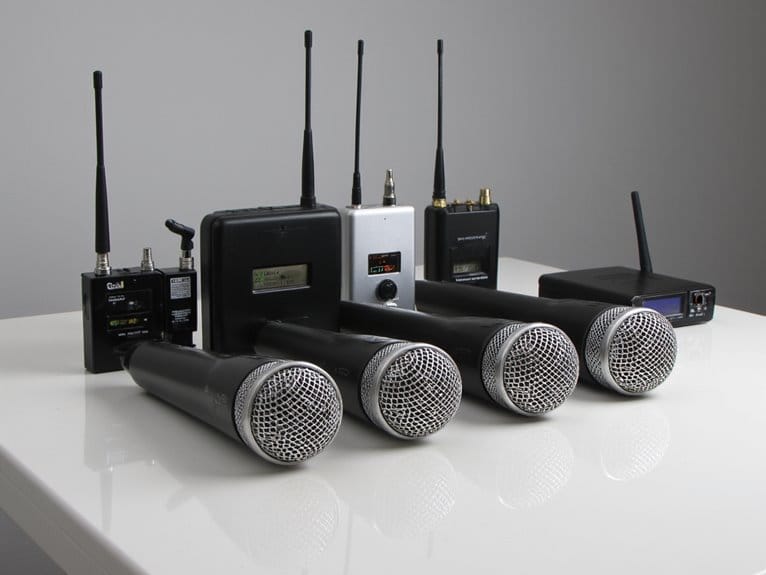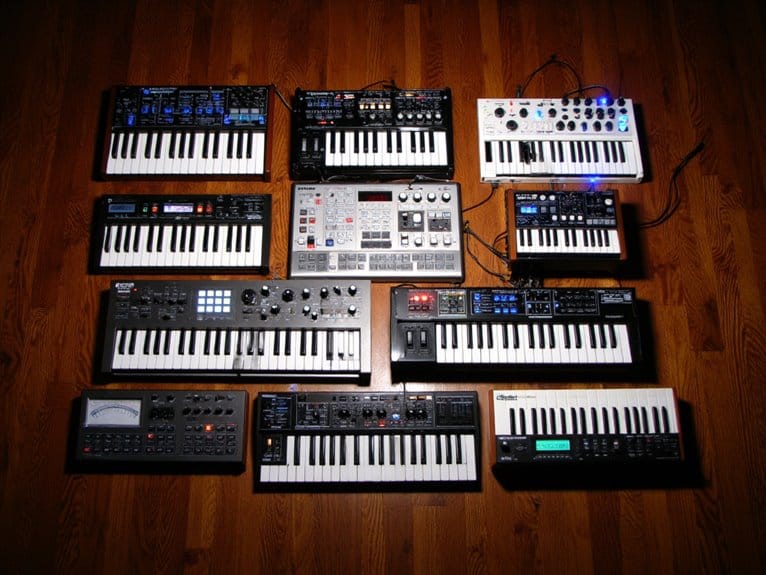Best Affordable Synthesizers That Don’t Break the Bank
I’ve tested dozens of budget synthesizers, and my top picks include the Behringer 2600 GRAY MEANIE for vintage ARP character, Korg Volca Keys for analog loop synthesis, and Arturia MicroFreak with its 17 oscillator types and experimental features. The Novation MiniNova delivers professional-quality synthesis with 256 onboard sounds, while the classic Stylophone offers legendary portability since 1968. Each provides distinct sonic capabilities without exceeding reasonable budgets, though understanding their specific strengths will help you make the perfect choice for your musical needs.
We are supported by our audience. When you purchase through links on our site, we may earn an affiliate commission, at no extra cost for you. Learn more.
Notable Insights
- The Behringer 2600 GRAY MEANIE offers vintage ARP sound with semi-modular design at an affordable price point.
- Korg Monotron Delay provides authentic analog filtering with built-in Space Delay effect in an ultra-portable format.
- Novation MiniNova delivers professional-quality synthesis with 256 onboard sounds and vocoder effects in compact design.
- Arturia MicroFreak features 17 oscillator types and extensive modulation capabilities for experimental sound design on a budget.
- Korg Volca Keys combines affordable analog sound with loop sequencing capabilities ideal for live performance applications.
Behringer 2600 GRAY MEANIE Semi-Modular Analog Synthesizer

While vintage ARP synthesizers command astronomical prices that put them out of reach for most musicians, the Behringer 2600 GRAY MEANIE offers an authentic analog experience that won’t require a second mortgage. This semi-modular beast packs three voltage-controlled oscillators, multi-mode filtering, and genuine spring reverb into an 8U rack-mount format that’ll have you crafting fat analog tones immediately. You’ll appreciate the authentic circuitry reproduction using selected opamps and transistors from the original 1970s design, though I’d recommend ordering extra patch cables since creative modular exploration becomes addictive quickly. With customers rating it 4.6 stars, you’re getting serious vintage character without the vintage headaches.
Best For: Musicians seeking authentic vintage analog synthesizer sounds without the high cost of original ARP equipment, particularly those interested in semi-modular synthesis and sound design experimentation.
Pros:
- Authentic analog circuitry reproduction of rare 1970s ARP Grey Meanie with selected opamps and transistors delivers genuine vintage character
- Semi-modular design requires no patching for immediate performance while offering extensive modulation possibilities for creative sound exploration
- Affordable alternative to astronomical vintage synthesizer prices while maintaining professional sound quality and spring reverb functionality
Cons:
- Inadequate shipping packaging frequently results in damaged components during transit, requiring careful inspection upon arrival
- Some units have reported defects, particularly with LED indicators and other components
- Additional patch cables needed for full creative potential are not included, adding to the overall cost
Electronic Musical Instrument, Portable Digital Music Synthesizer (Blue Whale)

Donop’s Electronic Musical Instrument, Portable Electric Digital Music Synthesizer in Blue Whale presents an intriguing entry point for young musicians who need their first taste of synthetic sound creation without the intimidating complexity of full-sized keyboards. At just 3x2x2 inches and weighing 8.8 ounces, this compact synthesizer won’t overwhelm small hands or cluttered bedrooms, though I’ll admit its whale-shaped design might confuse visitors about whether it’s a toy or serious instrument. The ABS and rubber construction feels surprisingly solid for the price point, while rear-mounted volume and pitch controls provide enough sound manipulation to keep budding producers engaged without drowning out household conversations—a feature parents will appreciate more than kids realize.
Best For: Young beginner musicians and kids who want to learn about synthesizers and sound creation without the complexity and size of full-sized keyboards.
Pros:
- Compact and lightweight design (3x2x2 inches, 8.8 oz) makes it highly portable and perfect for small hands
- Solid ABS and rubber construction provides durability with a smooth, skin-friendly touch
- Simple rear-mounted volume and pitch controls offer sound manipulation without overwhelming complexity
Cons:
- Limited volume output may not satisfy users wanting louder sound projection
- Whale-shaped design might blur the line between toy and serious musical instrument
- Very small size may limit the range of musical expression and playing techniques possible
Stylophone Original Pocket Electronic Synthesizer

Since its 1968 launch, this pocket-sized synthesizer has earned legendary status among musicians seeking authentic vintage sounds without breaking the bank, and frankly, I can see why artists like David Bowie and The White Stripes gravitated toward its distinctive retro tone. You’ll operate this unique instrument using a stylus that slides across its touch-sensitive metal surface, where each segment produces different notes across three octaves with optional vibrato effects. At just 2.05 x 3.41 x 1.86 inches and weighing 8.8 ounces, it literally fits in your coat pocket while running on three AA batteries, making it incredibly portable for spontaneous music creation anywhere you go.
Best For: Musicians, music enthusiasts, and beginners looking for a portable, affordable synthesizer with authentic vintage sounds and unique playability that’s easy to learn and take anywhere.
Pros:
- Extremely portable design that fits in a coat pocket and runs on AA batteries with built-in speaker and headphone options
- Unique stylus-controlled interface with touch-sensitive metal surface offers distinctive retro sound used by famous artists like David Bowie
- Versatile connectivity with 3.5mm output for connecting to computers and other gear for sound enhancement and music manipulation
Cons:
- Steep price point considering its novelty factor and limited functionality compared to full-featured synthesizers
- Learning curve required to effectively use the stylus-based playing technique and master the instrument
- Limited range with only 3 octaves and basic vibrato effect may restrict advanced musical compositions
Korg Monotron Delay Analog Ribbon Synthesizer

When you’re starting your synthesizer journey or need an ultra-portable analog synth that won’t break the bank, the Korg Monotron Delay delivers authentic analog tones in a pocket-sized package that weighs just 6.4 ounces. You’ll get four octaves of expressive play through its distinctive ribbon controller, though precise note-playing takes practice compared to traditional keys. The analog filter, derived from Korg’s classic MS-10 and MS-20 synthesizers, provides genuinely warm tones that sound remarkably rich for such a compact device. Its built-in Space Delay effect adds analog-style echo, while the pitch LFO offers selectable waveshapes for sound modulation that keeps things interesting during extended play sessions.
Best For: Beginners learning synthesizer fundamentals, musicians seeking an ultra-portable analog synth for experimentation, and anyone wanting authentic analog tones without a major financial investment.
Pros:
- Authentic analog filter derived from classic MS-10 and MS-20 synthesizers delivers genuinely warm, rich tones
- Ultra-portable design at just 6.4 ounces with battery power makes it perfect for music on the go
- Built-in Space Delay effect and versatile LFO with selectable waveshapes provide excellent sound modulation capabilities
Cons:
- Built-in speaker offers limited sound clarity compared to external audio systems
- Ribbon controller makes precise note playing challenging compared to traditional keyboard keys
- Plastic construction raises some durability concerns for long-term use
Bowie Stylophone – Limited Edition Synthesizer

The Bowie Stylophone transforms David Bowie’s iconic Space Oddity instrument into an accessible, limited-edition synthesizer that’s perfect for fans seeking both musical nostalgia and genuine creative potential. This compact, one-pound device features a special white design with embossed Bowie logo, three modes for classic analog synth and bass sounds, and built-in speaker quality that actually delivers. While you’ll find audio out capability for recording, there’s no aux input in this edition, though that’s honestly fine for most casual users. With 4.6 stars from 1,267 reviews and ranking #1 in tabletop synthesizers, it’s clearly resonating with both beginners and experienced musicians looking for an affordable, battery-powered instrument that encourages experimentation.
Best For: David Bowie fans, beginner musicians, and anyone seeking a portable, nostalgic synthesizer that’s easy to use and encourages musical experimentation.
Pros:
- Compact and lightweight design (1 pound) with battery power makes it highly portable for music creation anywhere
- Strong customer satisfaction with 4.6/5 stars and #1 ranking in tabletop synthesizers category
- Three different modes provide versatile analog synth and bass sounds with built-in speaker and audio out capability
Cons:
- No auxiliary input functionality limits connectivity options compared to other synthesizers
- Some users report issues with audio output volume levels
- Limited edition status may affect long-term availability and potential future support
Novation MiniNova Analogue Modelling Compact 37 Mini-key Synth

If you’re seeking professional-grade analog modeling synthesis in a truly portable package, the Novation MiniNova delivers the full sound engine of its larger UltraNova sibling while weighing just six pounds and fitting comfortably in a backpack. You’ll access 256 onboard sounds across 18 voices, each equipped with three oscillators and fourteen filter types, plus five simultaneous effects including distortion, reverb, and the signature gator effect. The eight animate buttons provide real-time sound manipulation, while the included MiniNova Editor software offers visual sound design within your DAW, making complex synthesis surprisingly accessible for both studio work and live performance.
Best For: Musicians and producers who need professional-quality analog modeling synthesis in a highly portable format for both studio work and live performances, especially those who value real-time sound manipulation and visual editing capabilities.
Pros:
- Full UltraNova sound engine with 256 sounds, 18 voices, and comprehensive synthesis features (3 oscillators, 14 filter types, 5 effects per voice) in an ultra-portable 6-pound package
- Extensive real-time performance controls including 8 animate buttons, vocoder, VocalTune effect, and arpeggiator for dynamic live manipulation
- Complete editing ecosystem with visual MiniNova Editor software, DAW integration, and ability to save 128 custom sounds with additional storage via Patch Librarian
Cons:
- Mini-keys may feel cramped for players accustomed to full-size keyboards, potentially limiting playability for complex performances
- Limited to 37 keys, which restricts range for two-handed playing and complex chord progressions
- Analog modeling rather than true analog circuitry, which some purists may prefer for authentic vintage synth character
Arturia MicroFreak Synthesizer Keyboard (25-Key Hybrid Synth)

Musicians seeking serious sound design capabilities without the heavyweight price tag will find the Arturia MicroFreak Synthesizer Keyboard offers an impressive blend of experimental features and practical functionality that punches well above its weight class. You’ll get 17 oscillator types, including collaborations with Mutable Instruments and Noise Engineering, plus a resonant analog filter that shapes your sonic explorations with precision. The unique flat PCB keyboard detects individual pressure and aftertouch on each key, though some users find the capacitive touch sensitivity unpredictable during performance. With CV outputs for modular integration, a 5×7 modulation matrix for signal routing, and extensive sequencing capabilities, you’re looking at serious sound design potential in a compact 2.42-pound package.
Best For: Musicians and producers who want advanced sound design capabilities and experimental synthesis features in a compact, affordable package, particularly those interested in modular integration and unique sonic textures.
Pros:
- 17 diverse oscillator types including collaborations with renowned manufacturers like Mutable Instruments and Noise Engineering
- Extensive modulation capabilities with 5×7 matrix and CV outputs for seamless modular synth integration
- Compact and lightweight design (2.42 lbs) with innovative flat PCB keyboard offering individual key pressure sensitivity
Cons:
- No built-in effects requiring external processing for enhanced audio
- Capacitive touch keyboard sensitivity can be unpredictable affecting playability during performance
- Steep learning curve for beginners unfamiliar with hardware synthesizers
Korg Volca Keys Analogue Loop Synthesizer

Compact enough to slip into a backpack yet powerful enough to anchor your home studio setup, the Korg Volca Keys stands out as an ideal entry point for anyone who’s been intimidated by the complexity of traditional synthesizers. With three-voice polyphony and stable analog oscillators, you’ll create rich chords and classic analog tones through its 27 touch-sensitive keys. The built-in 16-step sequencer, complete with motion sequencing capabilities, lets you craft intricate patterns while the intuitive knob layout encourages real-time sound sculpting. Though pattern storage remains limited to eight slots and the built-in speaker disappoints, its portability and genuine analog character make it worthwhile for beginners.
Best For: Beginners and musicians seeking a portable, affordable analog synthesizer that offers genuine analog tones and intuitive controls without the complexity of full-sized synthesizers.
Pros:
- Compact and portable design with battery operation makes it perfect for music creation anywhere
- Genuine analog oscillators deliver classic, warm analog tones with three-voice polyphony for rich chords
- Built-in 16-step sequencer with motion sequencing capabilities allows for complex pattern creation and real-time sound manipulation
Cons:
- Limited pattern storage with only 8 slots and no ability to save additional patterns
- Poor quality built-in speaker requires headphones or external speakers for proper sound reproduction
- Basic MIDI implementation lacks MIDI out functionality and velocity sensitivity on the touch-sensitive keys
Factors to Consider When Choosing an Affordable Synthesizer
When I’m helping you select an affordable synthesizer, I’ve found that balancing sound quality against price becomes the primary consideration, since cheaper units often compromise audio fidelity through budget components, lower-quality converters, and simplified signal paths. The choice between analog warmth and digital versatility will greatly impact your creative workflow, as analog circuits produce natural harmonic distortion and character that many producers crave, while digital options offer extensive preset libraries, complex modulation capabilities, and often better long-term reliability. I’d recommend carefully evaluating key count for your playing style, built-in effects that could eliminate external gear purchases, and connectivity options like MIDI, USB, and audio outputs, since these factors directly affect how well the synthesizer integrates into your existing setup.
Sound Quality Vs Price
The relationship between sound quality and price in affordable synthesizers presents a fascinating paradox that I’ve encountered countless times while evaluating budget-friendly instruments, where exceptional sonic capabilities can emerge from surprisingly modest price points. I’ve discovered that price doesn’t always predict performance, particularly with models like the Korg Volca series that leverage quality analog circuitry to deliver surprisingly warm, vibrant tones. When I assess budget synthesizers, I focus on waveform variety and modulation options, since these features dramatically expand sonic possibilities beyond basic functionality. I’ve learned that perceived limitations in entry-level models can be effectively overcome through external effects processing or strategic integration with other instruments, making connectivity options a vital consideration for maximizing value.
Analog Vs Digital Options
Although digital synthesizers dominate today’s affordable market with their impressive feature sets and reliable performance, I’ve found that choosing between analog and digital options requires careful consideration of your specific musical goals, workflow preferences, and sonic expectations. Digital models excel at precise sound replication through mathematical algorithms, offering extensive preset libraries, built-in effects, and software integration that streamlines modern production workflows. However, analog synthesizers provide that coveted warmth through continuous voltage control and physical oscillators, creating subtle variations that many producers find musically inspiring. While I appreciate the hands-on tactile experience of real knobs and sliders found in analog models, digital options often deliver more features per dollar, making them particularly attractive for budget-conscious musicians seeking versatility over vintage character.
Key Count and Size
After years of testing synthesizers in cramped studio spaces and hauling gear to countless gigs, I’ve learned that key count and size decisions can make or break your relationship with an instrument, especially when you’re working within budget constraints that don’t allow for multiple keyboards. I’ve found that 37-49 keys offer the sweet spot for most players, providing enough range for melodies and bass lines while keeping the unit portable. Mini keys initially felt cramped under my fingers, but they’re surprisingly playable once you adapt, and the weight savings are substantial for mobile setups. Full-sized keys with velocity sensitivity and aftertouch transform your playing dynamics, though these features often push affordable models beyond tight budgets.
Built-in Effects and Features
When you’re evaluating affordable synthesizers, built-in effects and features determine whether you’ll need additional gear or can create complete tracks right out of the box. I’ve found that synthesizers with reverb, delay, distortion, and vocal tuning options offer remarkable flexibility, eliminating the expense of external processors while expanding your tonal palette greatly. Multiple oscillator types, including analog and digital variants, enable diverse sound creation through unique waveforms and synthesis methods that I consider vital for creative exploration. Integrated sequencers provide intuitive pattern creation and looping capabilities, while real-time control knobs and sliders allow dynamic parameter manipulation during performances. Multi-voice polyphony becomes essential when you’re playing chords or creating layered soundscapes, giving your music the depth and complexity that distinguishes professional-sounding tracks from basic demonstrations.
Connectivity and Compatibility
While features determine what sounds you can create, connectivity options dictate how your affordable synthesizer integrates into your broader music setup, and I’ve learned that inadequate connections can severely limit your instrument’s potential. I prioritize MIDI and USB connectivity for seamless integration with other instruments, computers, and software, guaranteeing my synthesizer communicates effectively within complex setups. Audio outputs like headphone jacks and 3.5mm stereo connections are essential for connecting to external speakers, recording equipment, or mixing boards without requiring additional adapters. I examine auxiliary input capabilities that allow processing external signals through the synthesizer’s built-in effects, effectively expanding sonic possibilities. CV outputs provide compatibility with modular systems, while DAW software integration ensures efficient workflow management during recording and production sessions.
Portability and Power Requirements
Since mobility can make or break your synthesizer experience, I’ve discovered that portability and power requirements deserve careful consideration before making any purchase decision. I look for compact designs weighing under 5 pounds, which transform hauling gear from a workout into a simple grab-and-go situation. Battery operation proves essential for outdoor sessions, with most affordable models requiring 2 to 6 AA or AAA batteries that’ll keep you playing for hours. Built-in speakers eliminate the need for external amplifiers, though I’ve learned that lightweight plastic construction, while budget-friendly, sacrifices durability compared to heavier materials. Power adaptability matters too—having both battery and AC adapter options guarantees you’re covered whether you’re jamming in your bedroom or busking downtown.
On a final note
I’ve covered eight solid synthesizers that deliver genuine value without emptying your wallet, from the modular flexibility of Behringer’s 2600 to the quirky charm of the Otamatone. Each offers distinct sonic capabilities, build quality, and feature sets that cater to different musical needs and skill levels. Whether you’re starting your synthesis journey or adding affordable tools to your existing setup, these instruments prove that creativity doesn’t require premium pricing.

